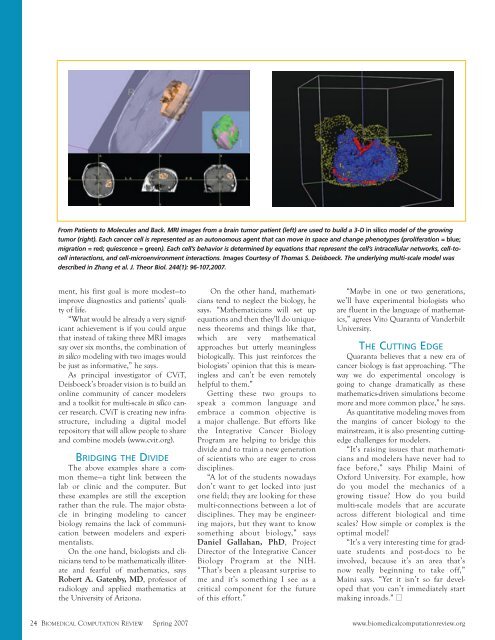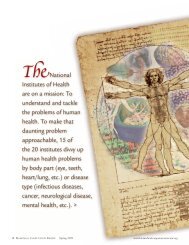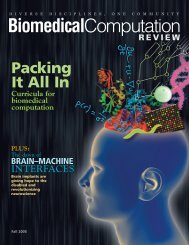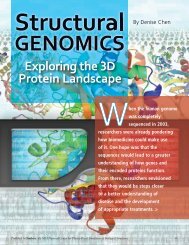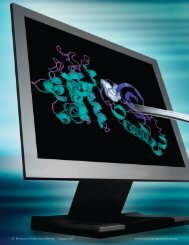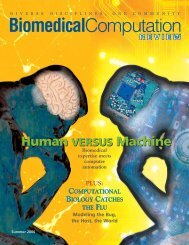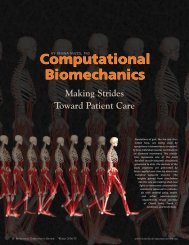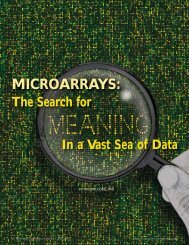Modeling Cancer Biology - Biomedical Computation Review
Modeling Cancer Biology - Biomedical Computation Review
Modeling Cancer Biology - Biomedical Computation Review
You also want an ePaper? Increase the reach of your titles
YUMPU automatically turns print PDFs into web optimized ePapers that Google loves.
From Patients to Molecules and Back. MRI images from a brain tumor patient (left) are used to build a 3-D in silico model of the growing<br />
tumor (right). Each cancer cell is represented as an autonomous agent that can move in space and change phenotypes (proliferation = blue;<br />
migration = red; quiescence = green). Each cell’s behavior is determined by equations that represent the cell’s intracellular networks, cell-tocell<br />
interactions, and cell-microenvironment interactions. Images Courtesy of Thomas S. Deisboeck. The underlying multi-scale model was<br />
described in Zhang et al. J. Theor Biol. 244(1): 96-107,2007.<br />
ment, his first goal is more modest—to<br />
improve diagnostics and patients’ quality<br />
of life.<br />
“What would be already a very significant<br />
achievement is if you could argue<br />
that instead of taking three MRI images<br />
say over six months, the combination of<br />
in silico modeling with two images would<br />
be just as informative,” he says.<br />
As principal investigator of CViT,<br />
Deisboeck’s broader vision is to build an<br />
online community of cancer modelers<br />
and a toolkit for multi-scale in silico cancer<br />
research. CViT is creating new infrastructure,<br />
including a digital model<br />
repository that will allow people to share<br />
and combine models (www.cvit.org).<br />
BRIDGING THE DIVIDE<br />
The above examples share a common<br />
theme—a tight link between the<br />
lab or clinic and the computer. But<br />
these examples are still the exception<br />
rather than the rule. The major obstacle<br />
in bringing modeling to cancer<br />
biology remains the lack of communication<br />
between modelers and experimentalists.<br />
On the one hand, biologists and clinicians<br />
tend to be mathematically illiterate<br />
and fearful of mathematics, says<br />
Robert A. Gatenby, MD, professor of<br />
radiology and applied mathematics at<br />
the University of Arizona.<br />
On the other hand, mathematicians<br />
tend to neglect the biology, he<br />
says. “Mathematicians will set up<br />
equations and then they’ll do uniqueness<br />
theorems and things like that,<br />
which are very mathematical<br />
approaches but utterly meaningless<br />
biologically. This just reinforces the<br />
biologists’ opinion that this is meaningless<br />
and can’t be even remotely<br />
helpful to them.”<br />
Getting these two groups to<br />
speak a common language and<br />
embrace a common objective is<br />
a major challenge. But efforts like<br />
the Integrative <strong>Cancer</strong> <strong>Biology</strong><br />
Program are helping to bridge this<br />
divide and to train a new generation<br />
of scientists who are eager to cross<br />
disciplines.<br />
“A lot of the students nowadays<br />
don’t want to get locked into just<br />
one field; they are looking for these<br />
multi-connections between a lot of<br />
disciplines. They may be engineering<br />
majors, but they want to know<br />
something about biology,” says<br />
Daniel Gallahan, PhD, Project<br />
Director of the Integrative <strong>Cancer</strong><br />
<strong>Biology</strong> Program at the NIH.<br />
“That’s been a pleasant surprise to<br />
me and it’s something I see as a<br />
critical component for the future<br />
of this effort.”<br />
“Maybe in one or two generations,<br />
we’ll have experimental biologists who<br />
are fluent in the language of mathematics,”<br />
agrees Vito Quaranta of Vanderbilt<br />
University.<br />
THE CUTTING EDGE<br />
Quaranta believes that a new era of<br />
cancer biology is fast approaching. “The<br />
way we do experimental oncology is<br />
going to change dramatically as these<br />
mathematics-driven simulations become<br />
more and more common place,” he says.<br />
As quantitative modeling moves from<br />
the margins of cancer biology to the<br />
mainstream, it is also presenting cuttingedge<br />
challenges for modelers.<br />
“It’s raising issues that mathematicians<br />
and modelers have never had to<br />
face before,” says Philip Maini of<br />
Oxford University. For example, how<br />
do you model the mechanics of a<br />
growing tissue? How do you build<br />
multi-scale models that are accurate<br />
across different biological and time<br />
scales? How simple or complex is the<br />
optimal model?<br />
“It’s a very interesting time for graduate<br />
students and post-docs to be<br />
involved, because it’s an area that’s<br />
now really beginning to take off,”<br />
Maini says. “Yet it isn’t so far developed<br />
that you can’t immediately start<br />
making inroads.” ■<br />
24 BIOMEDICAL COMPUTATION REVIEW Spring 2007 www.biomedicalcomputationreview.org


